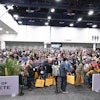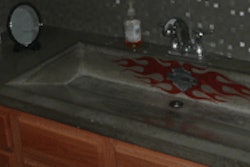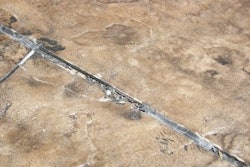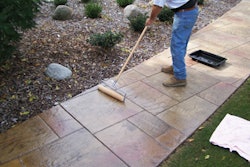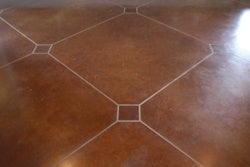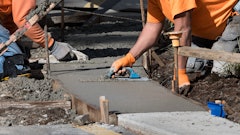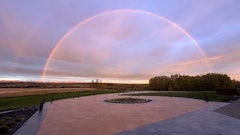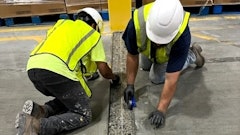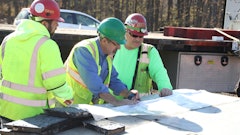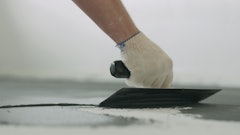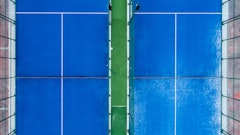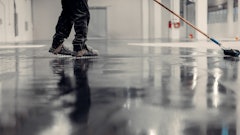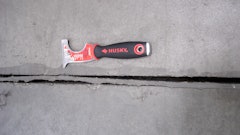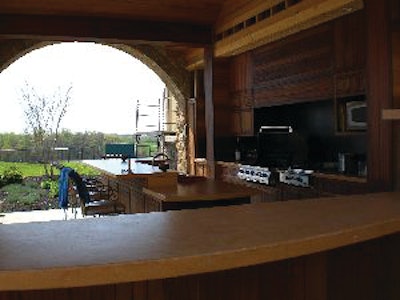
Concrete Jungle, Inc.
Concrete Jungle, Inc., Frederick, Md., has been in business for 13 years, and it is seeing a growing trend in concrete countertops for outdoor kitchens, says Kelly Carr, president and owner of Concrete Jungle. Recently, he completed a large outdoor kitchen project that took a total of one and a half months from start to finish.
Carr created multiple countertops, including an island, with multiple levels. "We came up with the idea of doing an upper top and a lower top. The concrete is broken up into levels and makes it more appealing to the eye."
Carr measured the site and then created templates and moulds to precast the countertops back at his shop. Once all knockouts were in place - some of the countertops included sinks and cook tops - it was time to pour. He added Davis Color red and yellow pigments to the concrete mix prior to precasting to create a pumpkin shade for the final look. He also placed reinforcement wire where necessary. Carr, who trained with Buddy Rhodes for a year before starting his business, hand packs all of his concrete countertops.
He also cuts all seams the next day. "The first thing I always think about is how we are going to seam this," Carr says. "We like to cut the seam the next day so the concrete can cure at its own speed. A lot of times seams are near sinks where if you don't cut the seam the area could heat up and shrinking and cracking could occur," he adds. Creating an upper and lower countertop also helped Carr decrease the overall size and weight of the pieces making for easier transportation and installation.
Using a wet diamond polisher, he polished the countertops and edges, which were ground before polishing. The countertops cured for a week and then were transferred to the home where they were sealed onsite with Pro-Seal Ultra Shield II-A, Carr says.
Perhaps the biggest challenge when it comes to outdoor concrete countertops is cutting out holes for the appliances, Carr says. "If the hole's too big you can't fix it." Plus, sometimes appliances - even from the same manufacturer - will not always line up directly when placed in the cutouts. "The biggest challenge on this and any outdoor kitchen is knowing the appliances. You need to know how to marry up the appliances to work in the concrete," he says. Contractors who do outdoor concrete countertops need to make sure they are as functional as indoor countertops, Carr says. Sinks should not be too deep or too far back from the edge.
With this project, even though it was big, Carr was able to give the homeowner the look and functionality desired. "It was still a hefty product but used in a way it looked kind of soft."
Concrete Interiors
Concrete countertops allow contractors the ability to be creative with the inclusion of special aggregates such as glass. But a new product available is Ambient Glow Technology. Similar to the look and size of stone, AGT is a glow-in-the-dark concrete aggregate. Nick Coello, operations manager of Concrete Interiors, Waukesha, Wis., recently created a bathroom vanity, integral sink, and backsplash using concrete and AGT.
The precast, 6-foot by 26-inch countertop used 2 cubic feet of concrete and took Coello two and a half weeks to complete. The countertop was done in one seamless piece while the backsplash was done separately.
Coello used a melamine mold with a polyurethane sink mold to form the countertop. He also used wooden dowels for the faucet knockouts, which he sprayed with form release before placing in the mold.
The countertop included both 8-millimeter AGT as well as turquoise and amber glass, Coello says. He used a 3M spray adhesive to glue the AGT and the decorative glass to the surface of the mold and added steel reinforcement before pouring the concrete.
Coello used Cheng Pro Formula Mix in Platinum to get the color for the countertop. The color was dry mixed with the concrete before adding it to a 12-cubic-foot Imer electric mixer where it was mixed with water. As he poured the concrete into the mold, he used a vibrating table to vibrate the concrete. "We go over the edges at the end with a pencil vibrator, but the table vibrator gets the whole top evenly," Coello says. "Plus, it's out of the way under the table."
Coello used a hand trowel to finish the bottom of the countertop and sink. A plastic tent and warm mist humidifier helped control humidity while the countertop cured for three days.
Next, Coello used a 5-inch wet polisher and diamond pads to expose the aggregate and AGT. He started with a 50-grit and went up to 3,000-grit for polishing. The sink was done using hand polishing pads, Coello says. He used Cheng Pro Formula Sealer to seal the finished countertops, burnishing pads to smooth any air bubbles from the sealer and then finished with a wax and final polish.
This was the first time Coello had used the AGT for a countertop, and he was pleased with the result. "It ground very nice and shined up no problem. We treated it just like any other decorative aggregate." The AGT, which has a pale white color when not glowing and in this case a blue color when glowing works almost as a night light, Coello says. It takes only 10 minutes to charge and can glow for up to 10 hours, he adds. For this countertop, AGT acts as both a decorative and practical feature for the homeowners.
To read about more decorative concrete countertops see our article "Concrete Countertops" from the April/May issue of Concrete Contractor.




